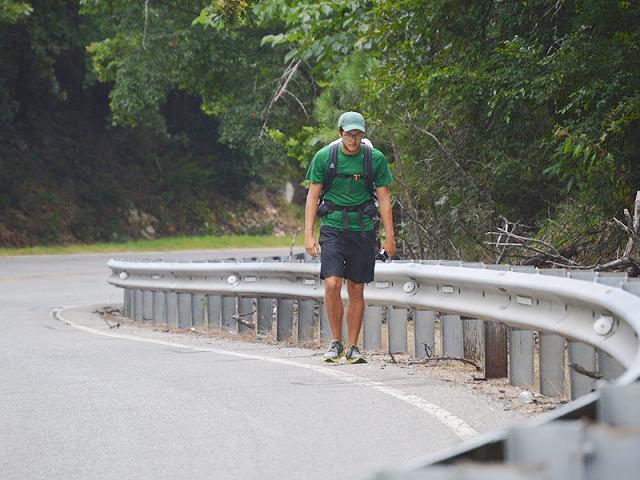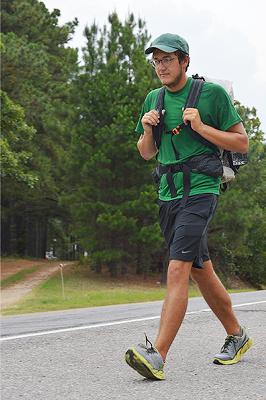 |
Canku Ota
|
 |
|
(Many Paths)
|
||
|
An Online Newsletter
Celebrating Native America
|
||
|
August 2016 - Volume
14 Number 8
|
||
|
|
||
|
Fletcher Hikes Most
Of Northern Trail Of Tears Route
|
||
|
by Stacie Guthrie -
Reporter Cherokee Phoenix
|
||
|
credits: photos by Stacie
Guthrie - Cherokee Phoenix
|
|
TAHLEQUAH, OK – Cherokee Nation citizen Chance Fletcher, 20, spent June retracing approximately 900 miles of the Northern Route of the Trail of Tears. He started at Red Clay State Park in Tennessee on June 2 and finished on July 1 at the Cherokee Courthouse.
The Trail of Tears marks the path Cherokees were forced to take when removed from their southeastern homelands during the winter of 1838-39. Fletcher, of Oologah, said he was able to hike the trail because of the Dale Summer Award he received from Princeton University. "You just sort of cook up whatever you want to do and I was like, 'You know, I never heard of anybody hiking the Trail of Tears,'" he said. "I just kind of applied on a whim. I didn't really think I was going to get it … I ended up getting it. I bought my gear and here I am." He said the route he traced was similar to the one the "Remember the Removal" riders took. He said some differences for his hike included starting at Red Clay whereas the cyclists began in New Echota, Georgia. Also, he wasn't able to travel by boat on some portions so he took alternate paths.
Fletcher said he hiked approximately 30 miles a day depending on the type of day he faced. "It really depended on the day, how hot it was. Some days I do a lot more. Some days I do a lot less," he said. He said when it was time to settle down for the night he tried to stay at churches. "I tried to stay mostly in churches' yards because I kind of figured out that one, they would be nice to you and two, they might feed you dinner so I wouldn't have to eat Clif Bars, which was nice, and three, people don't really mess…with churches so it's kind of…a safer option," he said. Fletcher said while on the route he stopped at some historic sites but not all. "Every historic site that was in a reasonable distance of the trail or the route that the "Remember the Removal" riders did…I stopped at," he said. "I kept a journal and wrote down all those places and I think this year, or maybe next year, when I drive up to school I'm going to take a southern route and visit those." Fletcher said hiking the trail was important because he had an ancestor that was removed along the trail. "I had an ancestor who was forcibly removed, and I think that there's really just something to be said about the juxtaposition between how I was treated and how my ancestor was treated at the time," he said. "Just the general hospitality that I was shown was almost just the exact opposite of what my ancestor was shown. These commonalities and differences, they're a lot deeper than that. A lot of people on the Trail of Tears didn't have shoes, you know. I can buy a new pair of shoes whenever I want on the trail. I think there really is a juxtaposition there…with they're walking away from their home and I'm walking home." |
||||||
|
|
|
|
||
|
|
||
| Canku Ota is a free Newsletter celebrating Native America, its traditions and accomplishments . We do not provide subscriber or visitor names to anyone. Some articles presented in Canku Ota may contain copyright material. We have received appropriate permissions for republishing any articles. Material appearing here is distributed without profit or monetary gain to those who have expressed an interest. This is in accordance with Title 17 U.S.C. Section 107. | ||
|
Canku Ota is a copyright ©
2000 - 2016 of Vicki Williams Barry and Paul Barry.
|
||
 |
 |
|
|
The "Canku
Ota - A Newsletter Celebrating Native America" web site and
its design is the
|
||
|
Copyright ©
1999 - 2016 of Paul C. Barry.
|
||
|
All Rights Reserved.
|
||


